Section One: The National Shooting Sports Foundation (NSSF) and the Firearms Industry
While the National Rifle Association functions as the unofficial trade association for the firearms industry, the NSSF is its official trade association. The role played by the NSSF within the gun industry is not unlike that which was played by The Tobacco Institute for the tobacco industry. NSSF issues a constant stream of publications both to support and defend the firearms industry in the marketing of its products.
NSSF marketing publications (some publicly available, others limited to NSSF industry members) that include a focus on outreach to minorities include: Recruitment of Hispanic Hunters: Using a Case Studies approach to gain insights into Hispanic values toward wildlife, and motivations and participation in hunting (2017); Changing Faces of the Shooting Sports: Meeting the Needs of an Increasingly Diverse Customer Base (2015); A Hispanic Market Study: Firearms and the Shooting Sports (2015); and, Understanding Diversity in Hunting and Shooting Sports (2013).10
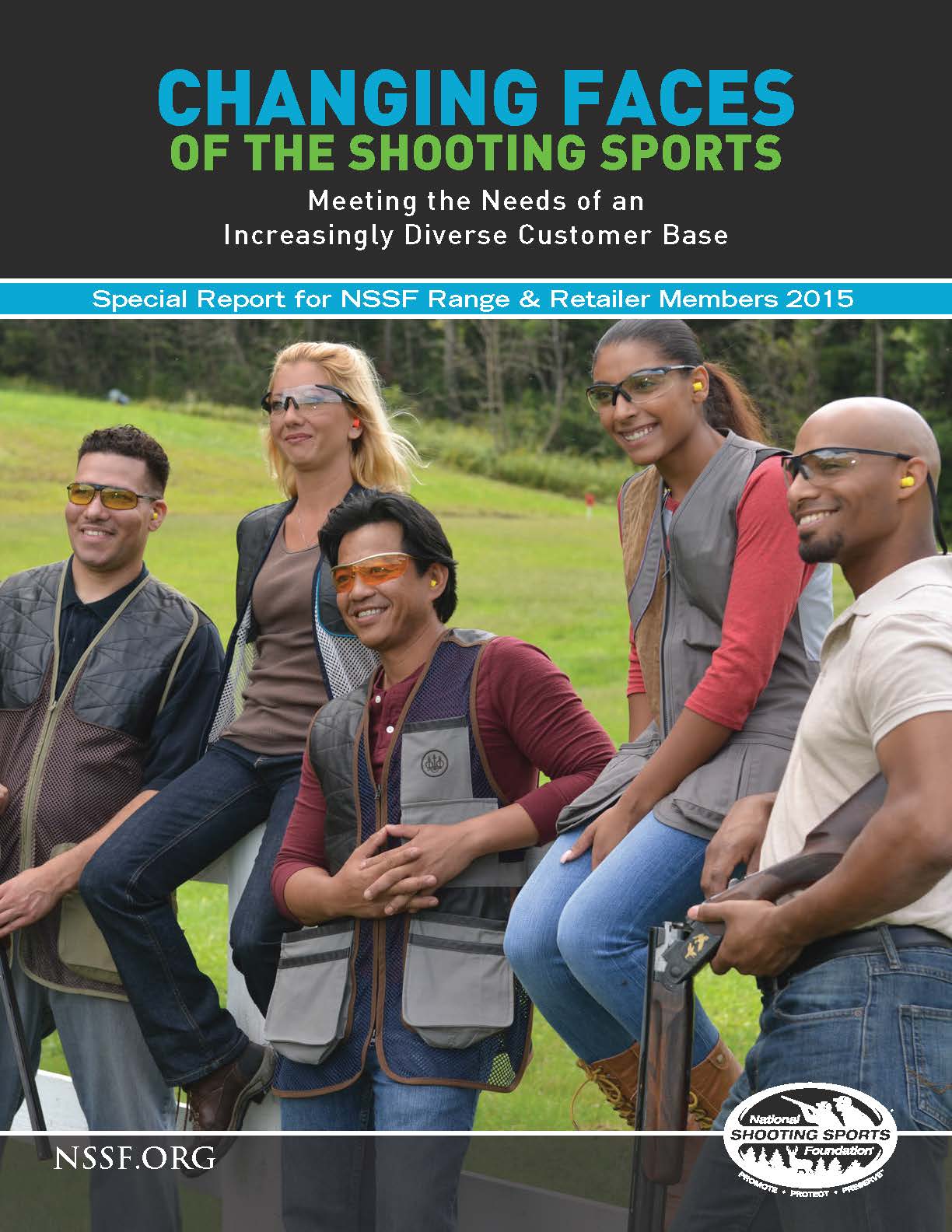
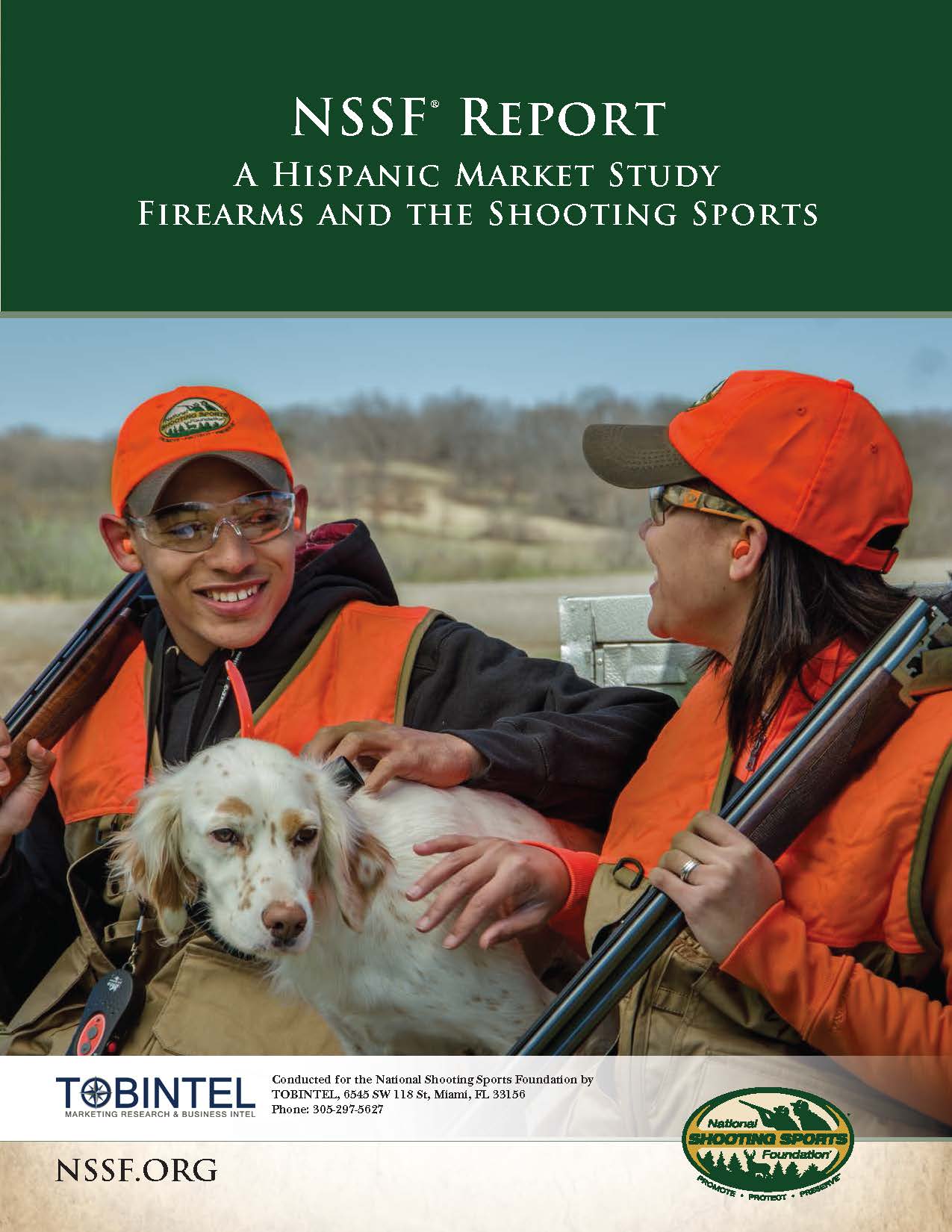
The birthplace of the long-term, organized, and coordinated effort by the firearms industry and gun lobby targeting non-white potential gun owners was the 2015 NSSF Industry Summit, which occurred in June of that year in Savannah, Georgia.11 As a press release issued by NSSF after the event explained:
The central theme of the 2015 Industry Summit, diversity, is one that proved the industry is preparing to significantly change the way it does business. ‘We’ve talked loosely about diversity for years,’ said Chris Dolnack, NSSF Senior Vice President and Chief Marketing Officer, ‘but there’s never been a cohesive effort across the industry as a whole to address this subject and innovate change. This year’s Industry Summit showed us that we’re about to experience a ground-swell shift in that attitude. Summit attendees came fully prepared, arriving with focused, on-point questions about what changes they need to make in their businesses to embrace a new consumer audience.’12
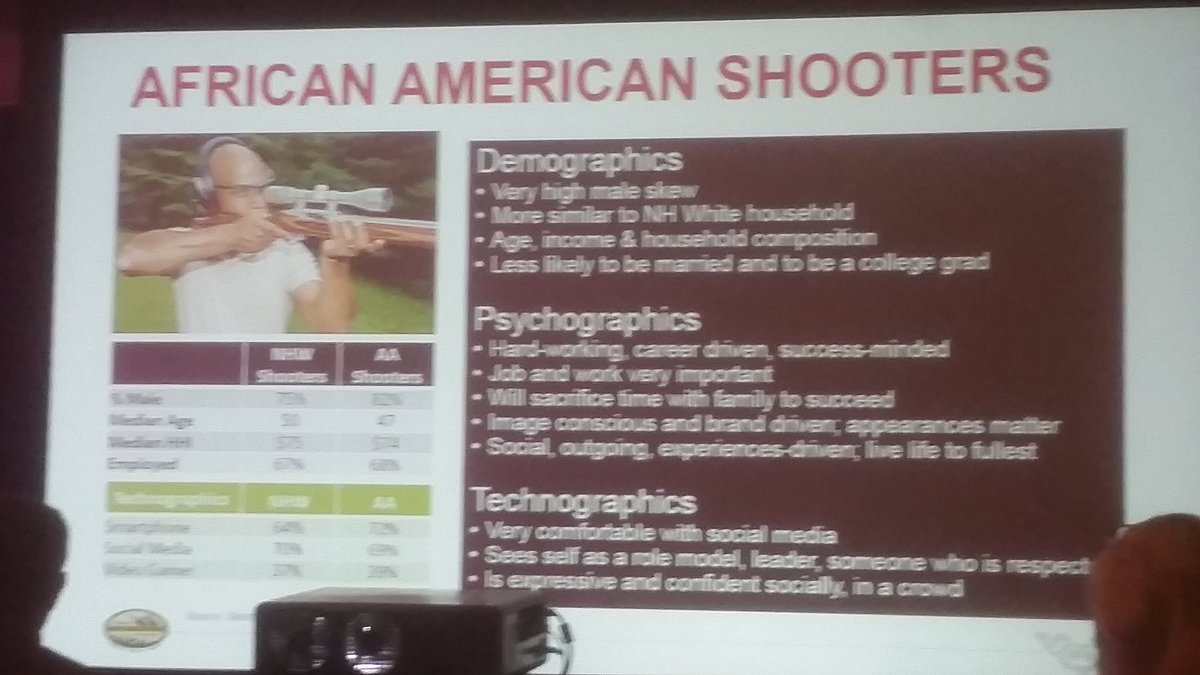
As seen by presentation slides shared on Twitter by Summit attendees, speakers offered overviews of the potential shooters they were targeting, breaking racial and ethnic groups down by “demographics,” “psychographics,” and “technographics.” The demographics for “African American Shooters” included: “Very high male skew; More similar to NH [Non-Hispanic] White household; Age, income & household composition; Less likely to be married and to be a college grad.” Psychographics were listed as: “Hard-working, career driven, success-minded; Job and work very important; Will sacrifice time with family to succeed; Image conscious and brand driven, appearances matter; Social, outgoing, experiences-driven, live life to fullest.” Technographics were listed as: “Very comfortable with social media; Sees self as a role model, leader, someone who is respected; Is expressive and confident socially, in a crowd.”
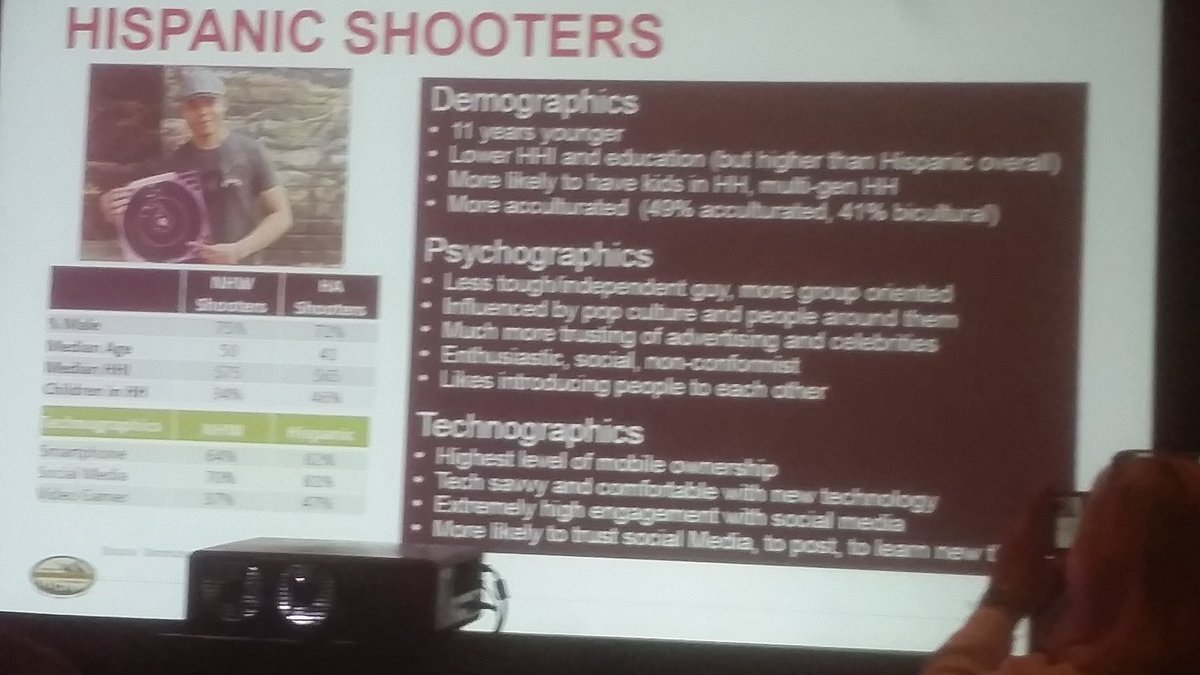
The demographics for “Hispanic Shooters” included: “11 years younger; Lower HHI [household income] and education (but higher than Hispanic overall); More likely to have kids in HH [household], multi-gen HH; More acculturated (49% acculturated, 41% bicultural.” Psychographics were listed as: “Less tough/independent guy, more group oriented; Influenced by pop culture and people around them; Much more trusting of advertising and celebrities; Enthusiastic, social, non-conformist; Likes introducing people to each other.” Technographics were listed as: “Highest level of mobile ownership; Tech savvy and comfortable with new technology; Extremely high engagement with social media; More likely to trust social Media, to post, to learn new [missing word].”
Among the speakers at the meeting was Chris Cheng, a one-time Google employee whose notoriety was based on his having won the History Channel‘s “Top Shot” shooting competition without any formal training or having won a prior shooting award. Cheng has worked on behalf of NSSF, with one NSSF article’s author describing him as “one of the more unlikely people I can think of to become a top shooter. He not only breaks many shooting sports molds, but rumor has it he even has the mold-makers on the run. Cheng is a techno-nerd, an Asian-American and openly gay — three things the stereotype monitors tell us you’re not supposed to find in the shooting sports.”13 Cheng has also served on NSSF’s Inclusion and Outreach Working Group.14
“What a difference this is from just a few years ago when the industry was lamenting that it was becoming stale, male and pale.” — Steve Sanetti, NSSF president and CEO
Cheng’s presentation was titled “Diversity: The Next Big Opportunity,” with the hoped-for result being “new shooters, and new gun owners, and new Second Amendment advocates….” As Cheng addressed his audience, he asked:
Now, what is diversity and why is it important…For the context of today’s talk, we’re talking about ethnicities like we’ve been talking about for most of the day. Hispanics, Asians, whites, Blacks. Now, this is important because in the context of America, we are a country of immigrants…[W]e then have to understand that a lot of immigrant families do not have traditions of firearms ownership, of hunting, of sports shooting. And therein lies the opportunity for us to promote the Second Amendment, to promote hunting and sports shooting to this new demographic and make them a multi-generational customer and a lifelong Second Amendment advocate.
Cheng concluded with a “call to action” including: “more targeted messaging towards ethnic groups…, sponsoring or attending diversity events such as the NSSF First Shots Program…, [a]nd then finally highlight people of color in firearm ads, media articles and other marketing collateral.” Cheng promised, “Diversity is the next area of success for our industry.”15

A slide from Chris Cheng’s presentation at the 2015 NSSF Industry Summit
Following the Summit, NSSF Senior Vice President and Chief Marketing Officer Chris Dolnack discussed the trade association’s marketing efforts:
[O]ver the years many of us have discussed how to expand shooting participation numbers beyond the traditional predominance of Caucasian males. We’ve made tremendous strides in welcoming women into the sport in the past couple decades,16 but we haven’t been as successful when it comes to ethnic diversity. And the thing is, there are legions of African-American, Hispanic and Asian recreational and competitive shooters out there, as well as hunters, but they aren’t part of the greater family of gun enthusiasts most are familiar with. We need to change that, need to create the avenues that will welcome these shooters into the fold, and that’s what this year’s Summit focused on.17
Or as NSSF president and CEO Steve Sanetti summarized, “What a difference this is from just a few years ago when the industry was lamenting that it was becoming stale, male and pale.”18
In the months following, the Industry Summit and its diversity goals were hailed in gun industry publications. Shooting Sports Retailer, in an article titled “Shooting Industry Must Talk the Talk With New Generation,” noted:
The summit theme was recruitment to replace the Baby Boomer generation that has done so much for the shooting sports…The NSSF believes that rapidly retiring demographic is unsustainable in the long run, and hence this meeting sought to alert attendees to looming population trends and to send folks home with an agenda: reach out to women and minorities.19
The article also warned:
And of course, the problem with failing to recruit and grow is that numbers equate to political power. In an era when the private ownership and use of firearms, the right to ‘keep and bear arms,’ has come under increasing pressure, numbers and a young, vital membership are critical.20
Among the photos supplied by NSSF for the article was that of a cheerful Black couple leaving a gun store. The text accompanying the photo stated:
By the year 2050, minorities will number more than half of all U.S. citizens. To preserve the future of the shooting sports in America, it is necessary to begin changing our message and presentation so that everyone feels welcome at the shooting line, in the deer woods and in our retail stores.21
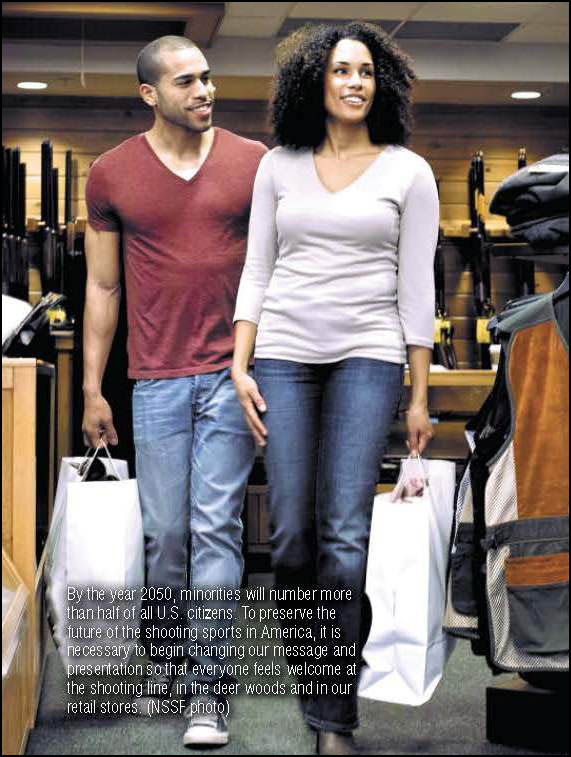
A photo supplied by NSSF is featured in an article in Shooting Sports Retailer
In its “Outlook For 2016,” Shooting Industry, under the heading “New Customer Base is Key,” observed:
When it comes to increasing diversity in the shooting sports, the industry has taken note — which is great news! [Consulting firm] Southwick Associates has been helping NSSF identify opportunities to engage with new customers and their motivations. There’s a huge untapped demand within the multi-cultural markets…It’s important for the industry to adapt to multi-cultural preferences and expectations, which will help welcome them into our ranks as active customers…Stay tuned: These new markets have the potential to start the next wave of growth for our industry.22
Bob Owens, editor of the pro-gun website Bearing Arms, who also participated in the NSSF event, wrote:
While there were a wide range of topics covered by the 21 speakers…, the clear intent of the 2015 Industry Summit was to reach out to minority communities, including African-Americans, Asians, Hispanics, and women.
This shows that the industry has been responsive to the increase in the number of young, urban, and female shooters, and is now try to be proactive so that the industry is poised to welcome diverse populations to the shooting sports. This is a Very Big Deal, as we’ve long stereotyped as the realm of ‘fat old white guys’ or the ‘pale, male, and stale.’
It was refreshing to see these sessions packed with industry leaders listening intently and taking notes on how to better meet groups on their own terms, in their own spaces.
The more effort we spend in sharing our love of shooting, the more friends and allies we will make, and the better we will be poised to protect and reassert our Second Amendment rights.
The future is bright.23
“The spectrum is not one color but full of beautifully different hues…It is time for us to embrace our differences. To not only see them, but also see beyond them to appreciate what makes us all the same. What is that? A love of firearms, and a desire for safety, education, and responsibility in every aspect of the shooting sports.” — Tisma Juett, NSSF
Since the 2015 Industry Summit, a focus on “diversity” has remained central to NSSF’s research and marketing efforts:
- At the 2016 Industry Summit held in Pittsburgh, Pennsylvania, plenary topics included “Engaging the Multi-Cultural Target Shooting Audience,” while breakout sessions included “The First Steps in Hispanic Outreach.”24
- A 2016 NSSF blog described new programs being tested by the organization regarding their effectiveness in expanding their customer base:
[S]tatistics show our core base of customers is still overwhelmingly comprised of older Caucasian males, while the face of America is increasingly heading in different directions. To help the industry adapt to changing times, NSSF is testing how to effectively engage new and diverse audiences through hands-on pilot initiatives.
Diversified customers can refer to many things: different races, ethnicities, ages, genders, and more. Therefore, identifying which customer segments offer the best growth opportunities, and how to successfully engage them, is the first task. Developing and testing tactics that retailers, ranges and others in the industry can effectively implement locally is the next step. In 2014 and 2015, NSSF has been engaged in these research and pilot testing efforts, and will continue to improve and expand in 2016 and beyond.25
- In 2017, NSSF published the marketing report Recruitment of Hispanic Hunters: Using a Case Studies approach to gain insights into Hispanic values toward wildlife, and motivations and participation in hunting.
- In 2018, Tisma Juett, whose title at the time was NSSF manager inclusion & outreach, wrote in the organization’s SHOT Business magazine about how virtually all societal divides and misunderstandings could be overcome by acknowledging “what makes us all the same…a love of firearms….” Wrote Juett:
The more different we are, the more we are all the same. Our country has been and is divided. Certain groups want to categorize people and put them into specific boxes to fit a particular agenda: black, white, conservative, liberal, straight, gay, revolver, semi-auto, MSR, bolt gun, young, old, baby boomer, millennial. Everything must be one or the other, without variance. Stay in your lane, on the straight road, don’t color outside your box.
The lines are not straight. The spectrum is not one color but full of beautifully different hues…It is time for us to embrace our differences. To not only see them, but also see beyond them to appreciate what makes us all the same.
What is that? A love of firearms, and a desire for safety, education, and responsibility in every aspect of the shooting sports.
We as an industry must become more inclusive and welcoming to those who do not know that we really are an industry for all law-abiding gun owners, conservationists, and outdoor enthusiasts. We must welcome those who want to join us regardless of race, color, country of origin, gender, age, sexual orientation, disability, or religion.26 27
- In 2018, Maj Toure, the founder of Black Guns Matter, which describes its primary goal as educating “people in urban communities in all 50 states on their 2nd amendment rights and responsibilities through firearms training and education,” 28 was a speaker at the NSSF-sponsored SHOT Show, the annual trade show for the firearms industry. Closed to the general public, the show is held each year in Las Vegas. During his presentation, Toure told his gun industry audience, “My job is to give you all the information to increase revenue as well as make a cultural shift.”29 Black Guns Matter was also a “Bronze level” sponsor of the 2018 SHOT Show University. In a press release announcing Black Guns Matter’s financial sponsorship, NSSF explained:
The era of cultural divide when it comes to firearms ownership should be a thing of the past, and thanks to the work of Maj Toure and Black Guns Matter, we’re a lot closer to that being a realization…He’s putting his money where his mouth is through this sponsorship, but his real impact will be in the ‘Black Guns Matter: Engaging Urban Communities in the 2nd Amendment Fight’ Retailer Seminar he’ll be conducting. All I can say is reserve your spot for this seminar now before it sells out.
During his seminar, Toure will present a highly interactive session on the misconceptions, myths and successes of engaging urban communities in the 2nd Amendment fight. Toure will share lessons he’s learned through hosting his 50 States Firearm Education Tour, take questions from the audience on engaging urban communities and explain how companies and organizations can support the Black Guns Matter movement. Anyone who is interested in building deeper connections with the urban demographic should make attending this session a top priority.30
That same year, Toure was featured in a photo of NSSF’s 2018 industry summit.
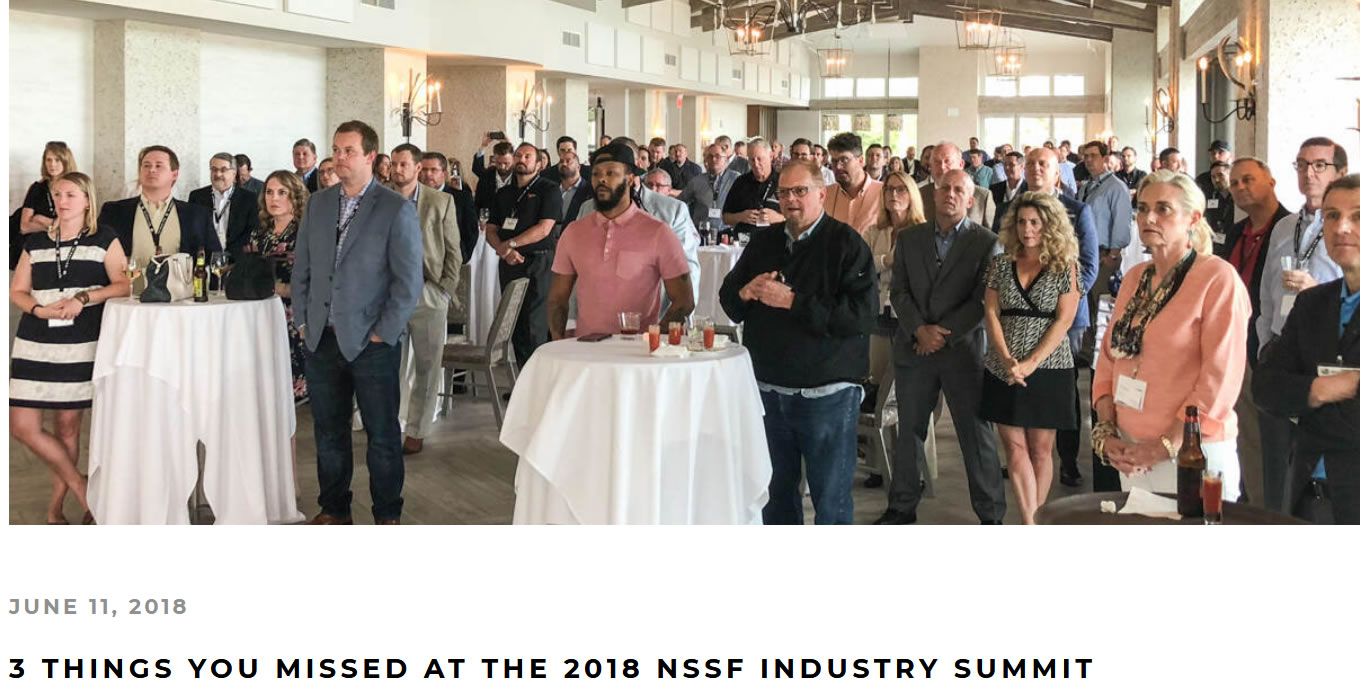
Maj Toure stands front and center at the 2018 NSSF Industry Summit
- In 2019, Toure attended the SHOT Show again, and was a guest on “SHOT Show TV.”31 During the interview Toure detailed how Black Guns Matter was now working with handgun manufacturer Bersa as a part of the gunmaker’s #BeginwithBersa marketing program for first-time shooters.32 He also discussed how he was partnering with rifle manufacturer Head Down Arms in the design and marketing of the Solutionary (a term coined by Toure to describe himself) AR-15 style assault rifle to financially benefit his organization.33
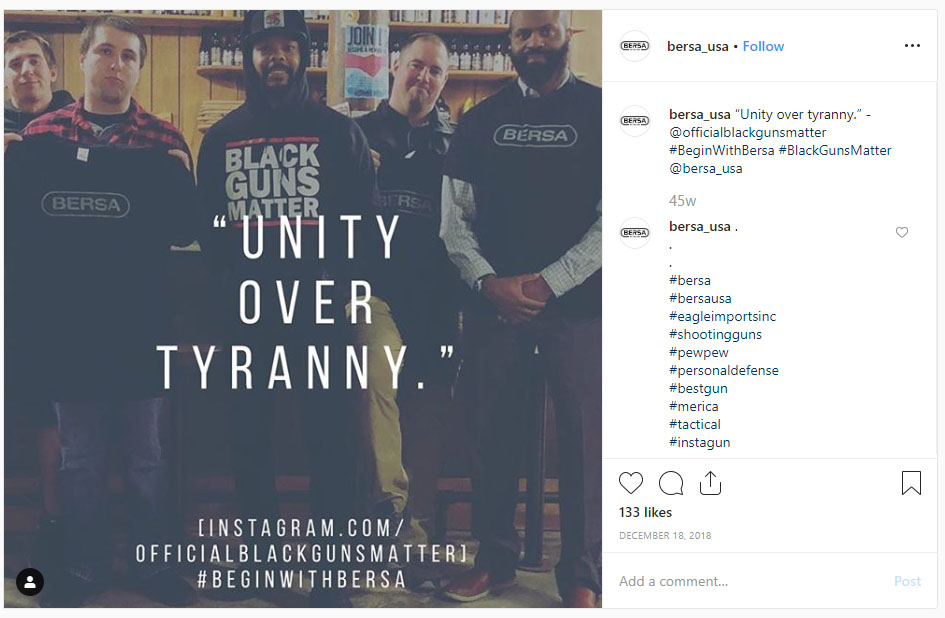
A 2018 social media post advocates “Unity Over Tyranny” while promoting Bersa’s partnership with Black Guns Matter in its #BeginwithBersa marketing program.
Examples of industry outreach and targeting efforts to potential Black and Latino gun buyers include the following.
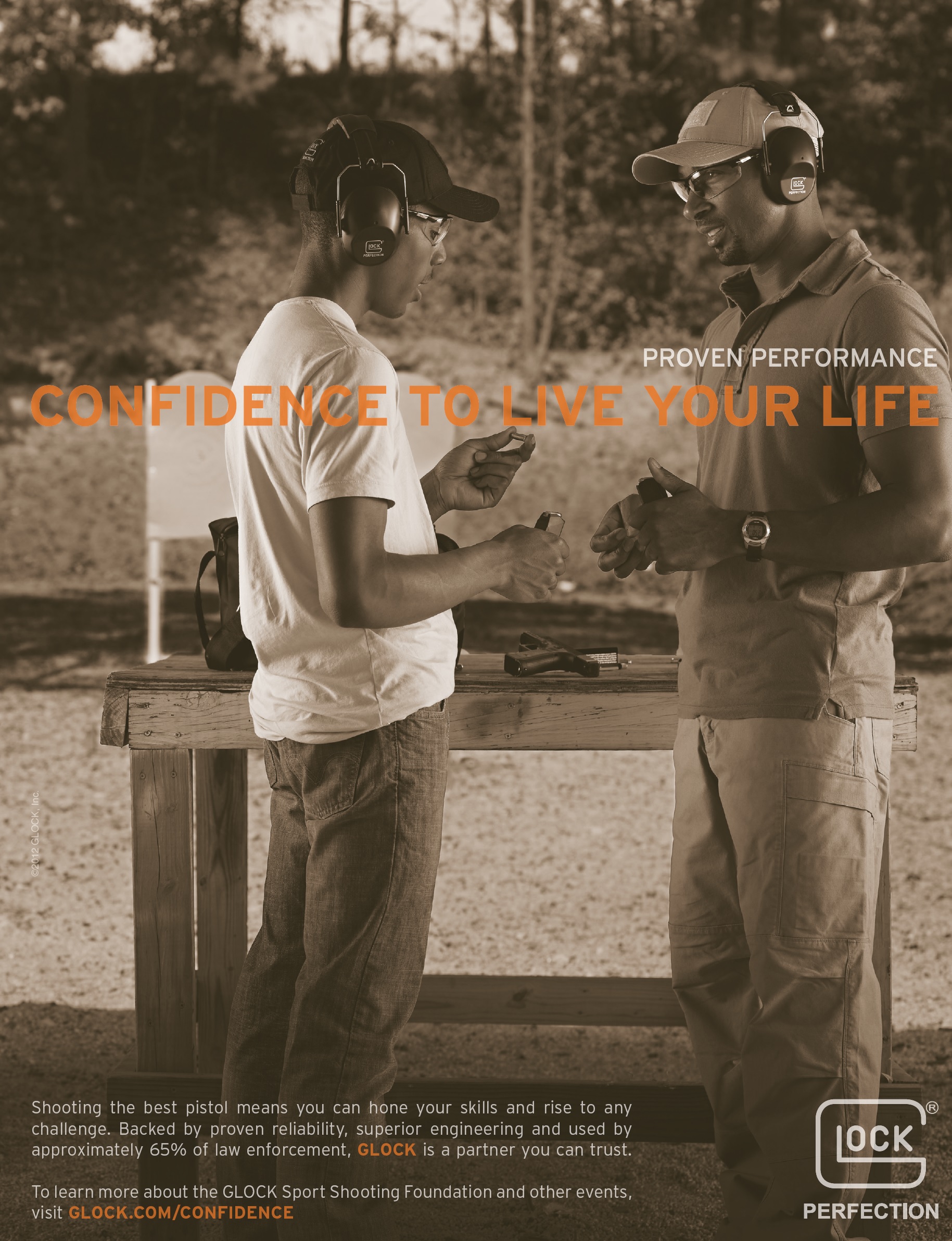
“Confidence to live your life”
A full-page ad appearing in the Spring 2013 issue of Junior Shooters34magazine shows two Black males, a youth and an adult, at an outdoor range, with the headline “Confidence to Live Your Life.” The ad, in which the youth is holding an ammunition magazine in one hand and a round in the other, states, “Shooting the best pistol means you can hone your skills and rise to any challenge. Backed by proven reliability, superior engineering and used by approximately 65% of law enforcement, GLOCK is a partner you can trust.”
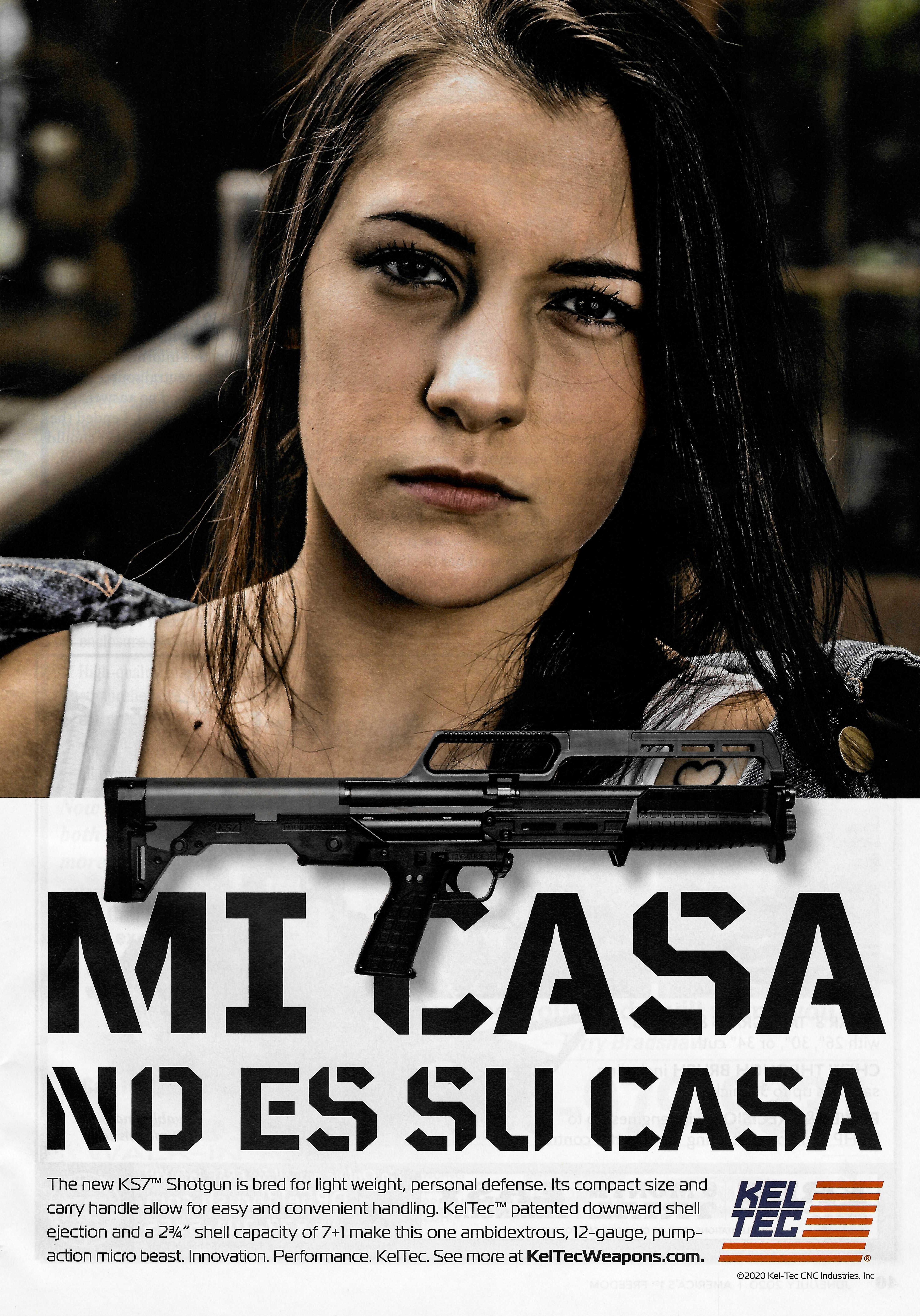
“Mi Casa No Es Su Casa”
An ad appearing in the June/July 2020 edition of the NRA’s America’s 1st Freedom (the organization’s activist magazine) for the KEL-TEC KS7 Shotgun warns, “Mi Casa No Es Su Casa.”
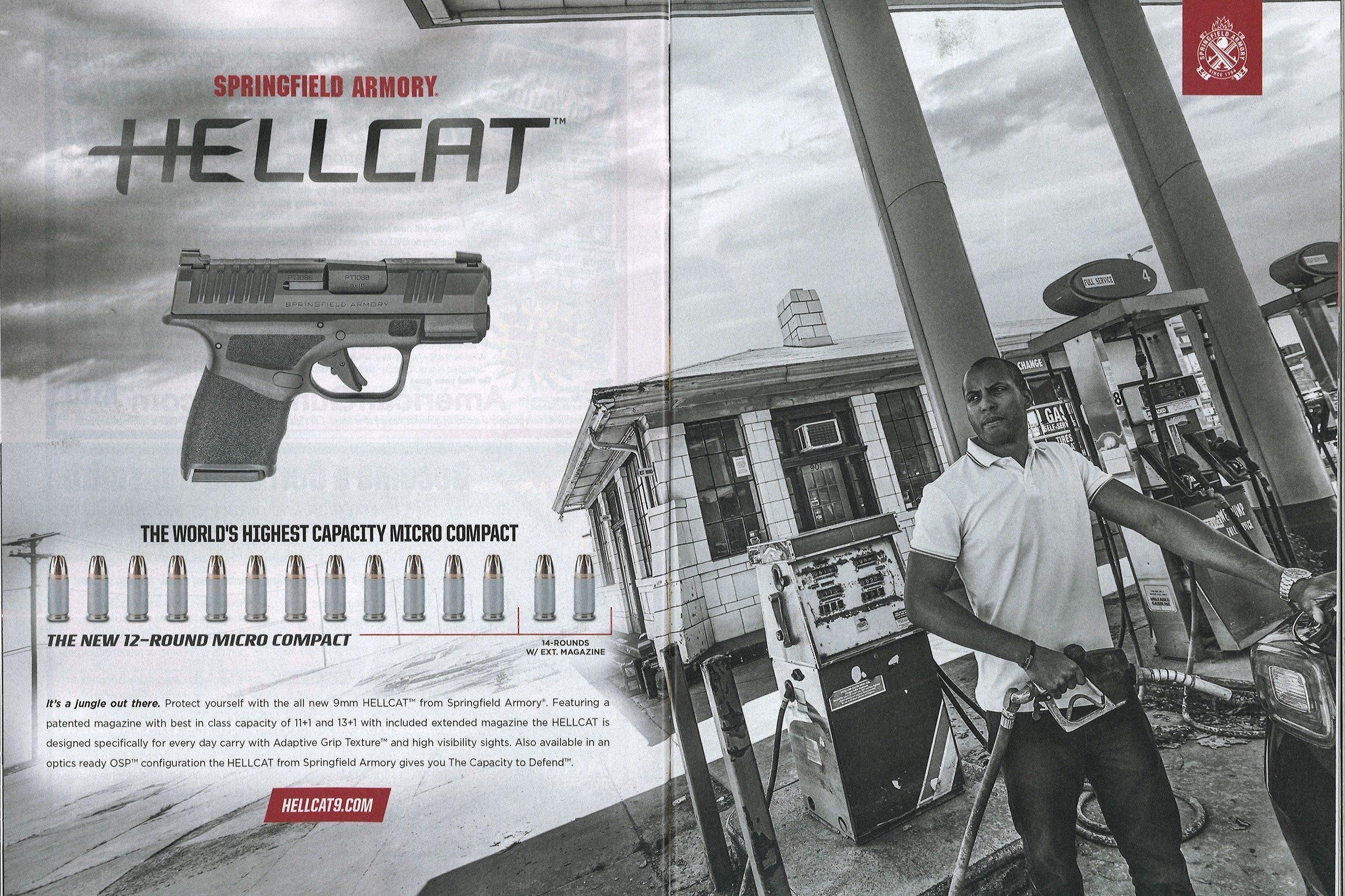
‘It’s a jungle out there”
An ad appearing in the December 2019 issue of Guns & Ammo magazine shows a Black man looking askance as he pumps gas into his car at a filling station. The ad warns, “It’s a jungle out there” and urges the reader to “Protect yourself with the all new 9mm HELLCAT from Springfield Armory.”
“It’s a jungle out there” — Springfield Armory ad for its HELLCAT pistol
An ad for the Smith & Wesson M&P (Military & Police) 9 Shield EZ pistol that appeared in both the October 2020 issue of the NRA’s American Rifleman magazine as well as the November 2020 issue of Guns & Ammo shows a Black woman, presumably preparing to leave for work, placing the pistol into her briefcase side pocket. The headline on the ad reads, “Protection Made Easy.”
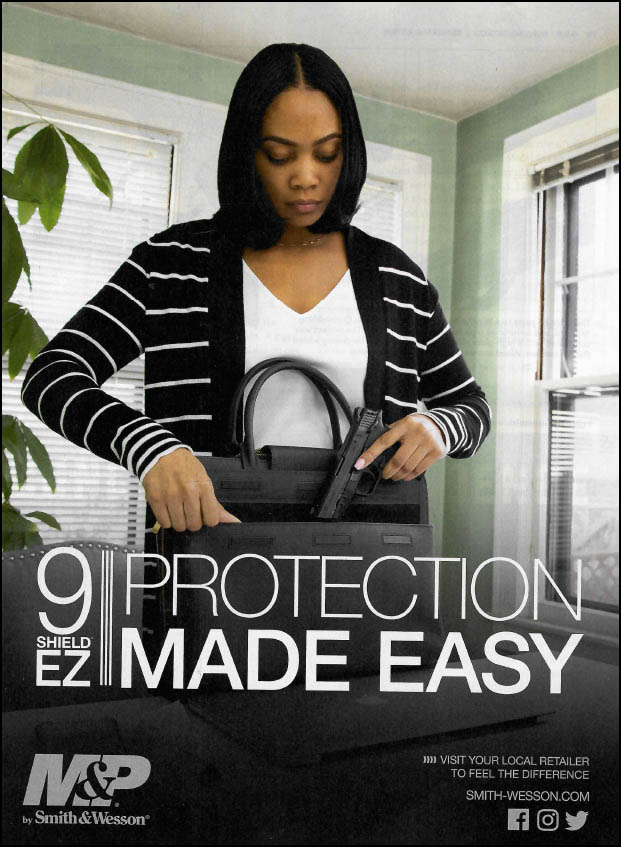
“Protection Made Easy”
Yet despite the joint efforts of the NSSF and gun manufacturers targeting non-white communities, and the ongoing research that in theory guides such efforts, NSSF’s own research reveals that one of the primary hurdles to overcome in engaging Blacks and Latinos in gun ownership is that although NSSF and gunmakers have, for their own purposes, identified communities of color as a great “untapped market” to exploit, the objects of their attention frequently don’t feel welcome in the firearms community as a whole, and gun stores in particular — despite NSSF’s stock photos to the contrary.
One early NSSF study, Understanding Diversity in Hunting and Shooting Sports, found that although nine to 14 percent of those surveyed “don’t feel welcome at a firearms retail establishment or range many don’t have any suggestions for how to improve the situation. For those who do have suggestions, there are no significant differences between ethnicities.” The “common suggestions” included, “Be less suspicious of non-whites/be more welcoming of other cultures.”35
Under the heading “Suggestions for Making People Feel Welcome,” Black respondents quoted in the study observed:
- In my area it seems to be a closed club for mostly single white men and their current girlfriends. Find a way to remove racial stereo-types on all fronts — White — Black — Hispanic, and others so that we all can enjoy what there is in this type of ‘sport.’ I believe unfortunately this is one area where stereo-typing and racial prejudice is still prevalent.36
- I would like to see more salespeople stop looking at me as if I stole something.37
These comments were echoed by Latinos interviewed for the study:
- I would like for the employees at shooting ranges to NOT have preconceived ideas about who would or would not be a good customer for them.38
- Sometimes because of your ethnicity and attire shop or range owners and employees tend to single you out for lest then [sic] stellar treatment. This has happened to me and my family at local and larger places.39
- Don’t make assumptions based upon color of skin. I walk in with my white father-in-law and he immediately gets waited upon.40
- Treat everyone equal and don’t judge by the color of skin or because someone has an accent.41
- Wider range of diversity. Would be nice to enter these locations and see someone other than a late/middle white gentleman behind the counter.42
Back to Table of Contents
Next – Section Two: National Rifle Association
10 Other marketing titles include: Millennials and The Shooting Sports: An In-Depth Exploration (2014); Understanding the Impact of Peer Influence on Youth Participation in Hunting and Target Shooting (2012); and, Understanding Activities that Compete with Hunting and Target Shooting (2012).
11 In a grim irony, NSSF’s headquarters is located in Newtown, Connecticut, site of the 2012 Sandy Hook school massacre.
12 “2015 NSSF Industry Summit Hits High Notes,” National Shooting Sports Foundation, press release, June 4, 2015 (https://www.nssf.org/2015-nssf-industry-summit-hits-high-notes/).
13 “Chris Cheng — An Unlikely Top Shot,” National Shooting Sports Foundation, November 20, 2018 (https://www.letsgoshooting.org/2018/11/20/chris-cheng-an-unlikely-top-shot/).
14 “What Does It All Mean?,” SHOT Business, October/November 2018.
15 “Diversity: The Next Big Opportunity,” presentation by Chris Cheng at the 2015 NSSF Industry Summit, June 23, 2015 (https://www.youtube.com/watch?v=4FZbiyEJJGo).
16 Despite NSSF’s claims of success in marketing guns to woman, according to the General Social Survey conducted by the National Opinion Research Center (NORC) at the University of Chicago, in 2018, 10.5 percent of females reported personally owning a firearm. In its 2015 report Trends in Gun Ownership in the United States, 1972-2014, NORC noted, “Personal ownership of firearms has not appreciably change[d] for women from 1980 through 2014. Between 9% and 14% of women personally owned a firearm during those years and there is no meaningful trend in the level of personal ownership.” The 2015 NORC study also noted that men “are much more likely to personally own a firearm than women are, but the gender gap has narrowed due to a decline in personal firearm ownership among men,” not an increase among women. In 1980, 50.3 percent of men owned a firearm while 10.1 percent of women owned a gun resulting in a gender gap of 40.2 percentage points. By 2018, male gun ownership had dropped more than 14 percentage points from 1980 to 35.8 percent, while female gun ownership in 2018 remained relatively stagnant at 10.5 percent, resulting in a gender gap of 25.3 points. For more information, see Trends in Gun Ownership in the United States, 1972-2014, Tom W. Smith and Jaesok Son, NORC at the University of Chicago, March 2015 (http://www.norc.org/PDFs/GSS%20Reports/GSS_Trends%20in%20Gun%20Ownership_US_1972-2014.pdf) and The Long-Term Decline of Gun Ownership in America: 1973 to 2018, Violence Policy Center, June 2020 (http://vpc.org/studies/ownership.pdf).
17 “NSSF Industry Summit Earns Rave Reviews,” NSSF Blog, June 12, 2015 (https://www.nssf.org/nssf-industry-summit-earns-rave-reviews/).
18 “Shooting Industry Must Talk the Talk with New Generation,” Shooting Sports Retailer, October 2015.
19 “Shooting Industry Must Talk the Talk with New Generation,” Shooting Sports Retailer, October 2015.
20 “Shooting Industry Must Talk the Talk with New Generation,” Shooting Sports Retailer, October 2015.
21 “Shooting Industry Must Talk the Talk with New Generation,” Shooting Sports Retailer, October 2015.
22 “Outlook For 2016,” Shooting Industry, January 2016.
23 “Diversity Becomes a Key Focus for the U.S. Gun Industry,” Bearing Arms, June 5, 2015 (https://bearingarms.com/bob-o/2015/06/05/diversity-becomes-key-focus-u-s-gun-industry/). All grammatical errors in original. In May 2017 Owens took his own life with a firearm near his North Carolina home. “Death of Bearing Arms editor and gun-rights advocate Bob Owens has been ruled a suicide,” Washington Post, May 9, 2017. (https://www.washingtonpost.com/news/post-nation/wp/2017/05/09/bearing-arms-editor-bob-owens-dead-from-apparent-self-inflicted-gunshot-wound/).
24 “NSSF Industry Summit Hits a Home Run in Pittsburgh,“ NSSF press release, June 9, 2016 (https://www.nssf.org/nssf-industry-summit-hits-a-home-run-in-pittsburgh-2-2/) and “Learn from Your Peers at the 2016 NSSF Industry Summit,” NSSF press release, May 3, 2016 (https://www.nssf.org/learn-from-your-peers-at-the-2016-nssf-industry-summit/).
25 “Multi-Cultural Interests in Target Shooting,” NSSF Blog, February 9, 2016 (http://www.nssfblog.com/multi-cultural-interests-in-target-shooting/).
26 “Embracing Our Differences,” SHOT Business, April/May 2018.
27 Prior to her tenure as manager inclusion & outreach, Juett was manager of NSSF’s First Shots, the organization’s primary recruiting program targeting new shooters. In 2015, NSSF held its first First Shots program in Spanish in Texas — with plans for further expansion. In December 2018, Juett became a regional member services representative for NSSF, where her job is to “provide highly personalized service to members in defined regions across the U.S., working side by side with FFL retailers, range owners and manufacturers to meet their needs and coordinate recruitment, reactivation and retainment efforts for the betterment of the entire firearms industry.” See “NRA, gun industry target Hispanics to broaden its appeal — and survive,” Fox News, December 1, 2016 (https://www.foxnews.com/world/nra-gun-industry-target-hispanics-to-broaden-its-appeal-and-survive) and “NSSF Adds Two Regional Member Services Representative to Roster,” National Shooting Sports Foundation press release, December 14, 2018 (https://www.nssf.org/nssf-adds-two-regional-member-services-representatives-to-roster/).
28 See https://blackgunsmatter.myshopify.com/.
29 “Black Guns Matter: 2018 Shot Show,” YouTube, January 28, 2018 (no longer available, video in files of Violence Policy Center).
30 “Black Guns Matter Signs as Bronze Sponsor of 2018 Retailer Seminar,” NSSF press release, January 4, 2018 (https://www.nssf.org/black-guns-matter-signs-as-bronze-sponsor-of-2018-retailer-seminar/).
31 “Black Guns Matter — 2019 SHOT Show TV Studio,” January 24, 2019 (https://www.youtube.com/watch?v=17uWvZ54U5U).
32 See https://www.instagram.com/explore/tags/beginwithbersa/top/?hl=en.
33 For additional information on the Solutionary AR-15 assault rifle, see “[SHOT 2019] NEW Head Down Arms ‘The Solutionary’ & Cerakote Options,” January 24, 2019 (https://www.thefirearmblog.com/blog/2019/01/24/shot-2019-head-down-arms-solutionary/).
34 Based in Boise, Idaho, the magazine “strives to be the first of its kind to promote juniors involved in all shooting disciplines…” and is “dedicated to juniors of all ages and their parents.” Promising content “For Kids By Kids,” the publication adds, “We care about kids and their parents and want you to have a place to go to find what is needed to get started in many different shooting venues.” See http://www.juniorshooters.net/aboutus/ and “Start Them Young” — How the Firearms Industry and Gun Lobby Are Targeting Your Children (http://www.vpc.org/publications/start-them-young/).
35 Understanding Diversity in Hunting and Shooting Sports, National Shooting Sports Foundation, 2013.
36 Understanding Diversity in Hunting and Shooting Sports, National Shooting Sports Foundation, 2013.
37 Understanding Diversity in Hunting and Shooting Sports, National Shooting Sports Foundation, 2013.
38 Understanding Diversity in Hunting and Shooting Sports, National Shooting Sports Foundation, 2013.
39 Understanding Diversity in Hunting and Shooting Sports, National Shooting Sports Foundation, 2013.
40 Understanding Diversity in Hunting and Shooting Sports, National Shooting Sports Foundation, 2013.
41 Understanding Diversity in Hunting and Shooting Sports, National Shooting Sports Foundation, 2013.
42 Understanding Diversity in Hunting and Shooting Sports, National Shooting Sports Foundation, 2013.






